Competing against the best from outboard-powered boats
This July, NFL® Hall of Fame Coach Jimmy Johnson brought his popular Quest for the Ring® Billfish Tournament Series North to the New Jersey resort town Atlantic City, and with it the opportunity for many tournament teams that have not experienced that level of competition and excitement to get in on the action.
Among them is a growing contingent of teams running high-powered center console boats ready to pit their skill, equipment and determination against an almost overwhelming field of much larger battlewagons—diesel-powered offshore fishing yachts, some as large as 90 feet. The big boats are managed by professional captains, crews and anglers, some even with hired guns paid to fish because of their level of expertise. These multimillion-dollar boats travel the eastern seaboard competing in big-money offshore tournaments from the Mid-Atlantic to Florida, the Bahamas, the Gulf of Mexico and even further south. Competing at this level is not for the faint of heart, or lean of pocketbook.
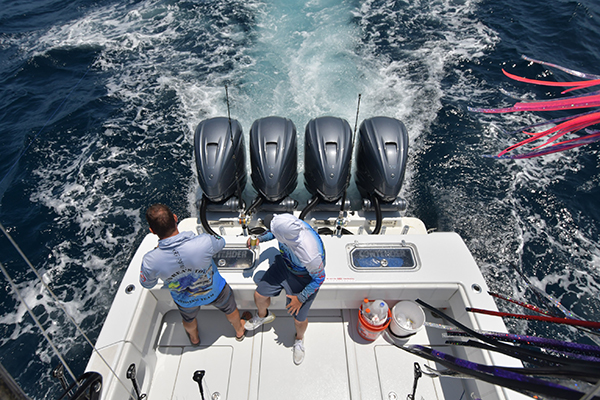
The Quest series has its roots in Florida, where it set the pace for high-stakes billfish tournaments during its inaugural tournament ten years ago. The latest series started with the new Atlantic City event in July, followed by the Miami Tournament of Champions, and it finishes up with the Championship Fishing Week event in South Florida. Yamaha is a multi-year sponsor of these tournaments and the Yamaha team has seen the number of outboard-powered boats competing in them increase significantly, especially in the Florida events. The advent of larger, faster center consoles sporting the latest generation of offshore outboards like Yamaha’s powerhouse 425-horsepower XTO Offshore® system makes them surprisingly competitive in southern waters where the target species is sailfish, typically found close to shore. That is not the case with the Atlantic City event, where the target species are white and blue marlin along with bigeye and yellowfin tuna - all canyon dwellers that typically require a run of up to 100 miles to get to the fishing grounds before lines in the water each day.
We spoke with three Yamaha pro captains and rode along with two on fishing days during the Quest to get their opinions and to provide a better understanding of the planning and execution that goes into competing at this level. Two weeks after the Quest tournament, all three teams competed again in the largest and richest billfish tournament of them all, the White Marlin Open in Ocean® City, Maryland.
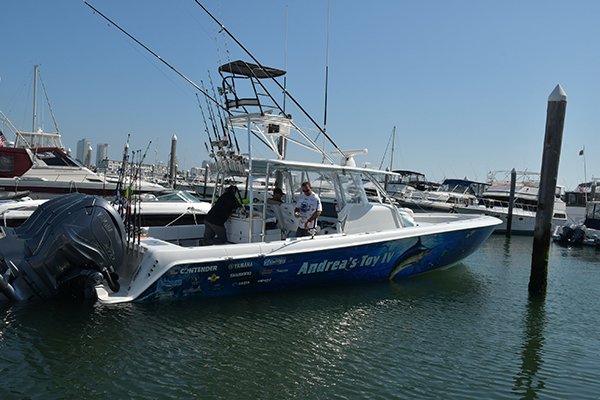
Capt. Freddy Gamboa – Andrea’s Toy
Freddy is a highly regarded charter captain from New Jersey who spends a good deal of his time offshore chasing tuna for his loyal clientele. His current boat is a 44 ST Contender® center console powered by four Yamaha XTO outboards for a total of 1700 horsepower. Recently highlighted in a Yamaha Saltwater Fishing feature on his techniques for run and gun tuna, Freddy is somewhat of a neophyte when it comes to fishing prestigious high-dollar tournaments like the Quest series. We rode along on the first fishing day to shoot pictures and watch his team in action.
“I’ve only been fishing the big offshore tournaments for the past three or four years, usually only two or three a year,” Gamboa said. He also fishes a few local offshore tournaments held near his home port in Pt. Pleasant, New Jersey. Two of his regular clients, T.J. Miller and Chris Vaughn, chartered his boat for this event. The remainder of the team consisted of seasoned captains and deckhands who have worked with him for years.
“My initial strategy was to concentrate on the tuna category, which offered a cash purse equal to the blue and white marlin categories,” Freddy said. “We ran a trolling spread of mostly lures and spreader bars the first day trying to tempt a bite from a large bigeye tuna. They turned out to be pretty elusive so we switched up for the next two days to include a mix of lures and rigged ballyhoo. We slowed our trolling speed to five-to-six knots to accommodate the ballyhoo and fished deeper water more likely to hold billfish.
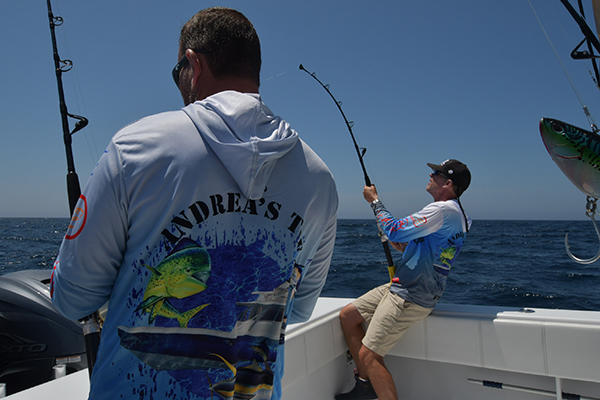
Freddy’s trolling spread included four tracker chains with ballyhoo on circle hooks, two ballyhoo under weighted Joe Shute skirts, two marlin plugs off the short riggers, one dredge bar and three Nomad® plugs run from flatlines. The change produced three tuna, one blue marlin and one white marlin release on the last day of fishing. Neither billfish was large enough to bring to the scales. As luck would have it, one minute after “lines out” on the last day of fishing, they hooked a very large white marlin, fought it to the boat, measured and released it. Chances are it would have won the white marlin division and received a very hefty payout since it was two inches longer than the winning fish. That’s tournament fishing for you. With all the planning and execution, sometimes mere seconds can be the difference between winning and losing.
When we asked Freddy about the advantages and disadvantages of fishing from an outboard powered boat against a large field of battlewagons with pro teams, he provided the following perspective.
“One of our advantages is speed. Sure, some of the big boats are fast, but we beat them to the grounds every day, often by an hour or more, which gave us extra time to look around while waiting for lines in,” he said. “The XTOs on my Contender are fast, powerful, smooth and dependable. They help offset some of the advantages the big boats have, but not all. The most difficult for us to overcome is many big boats are now equipped with Omni sonar, basically underwater radar. It can scan 360-degrees around the boat and dial in to track gamefish in real time. At one point, we were in the neighborhood of a bigeye tuna bite. The school of large tuna had five or six of the big boats tracking them with Omni, and they literally boxed out the competition from getting anywhere near those fish as they hooked one after another.”
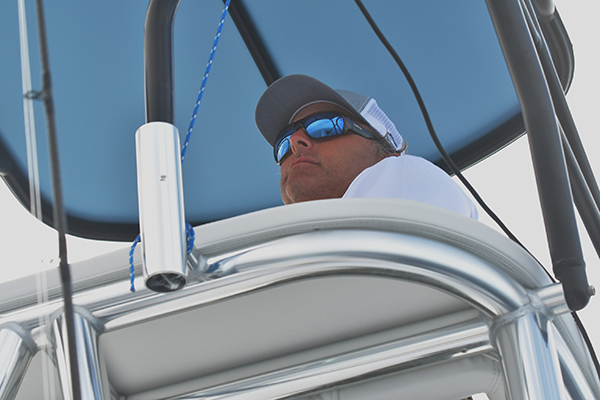.jpg)
Capt. Ken Pontari – Contender One
The factory tournament boat from Contender Boats, Contender One, has been a fixture in the Jimmy Johnson Quest tournaments since the inception of the series, in addition to other southern sailfish and offshore tournaments stretching further back than that. Like Yamaha, Contender is a sponsor of some of these events. The Atlantic City Quest event marked the first time Contender One ventured this far north to compete, and they needed a ringer at the helm. Luckily, they had one in house in Ken Pontari, the company production manager. Ken is a captain in his own right and a New Jersey native with years of experience fishing Mid-Atlantic bluewater tournaments from larger sportfishing boats. We caught up with Ken on the third day of the tournament for a ride-along to watch and photograph his team in the heat of battle. The team was made up of Contender/Yamaha pro staff members, Amanda Sabin, Contender’s director of marketing, and other company employees.
Pontari planned to target marlin exclusively, and he had the triple-Yamaha XTO powered 44 ST rigged for the task. In addition to the 22-foot outriggers, the boat was equipped with two of the latest Gemlux® 8-foot dredge booms mounted with LP® electric reels for fast deployment and retrieval of the heavy mullet dredges he used to attract marlin. He mounted the booms in rod holders opposite the lower helm station to give the boat a wider spread between the port and starboard dredges, and to get them out in the cleanest water to add to their power of attraction. In addition, he ran a pair of chain teasers from electric teaser reels mounted on the boat’s marlin tower, the perch where he spent his time while trolling so he could better scan the water and watch for billfish coming into the trolling spread.
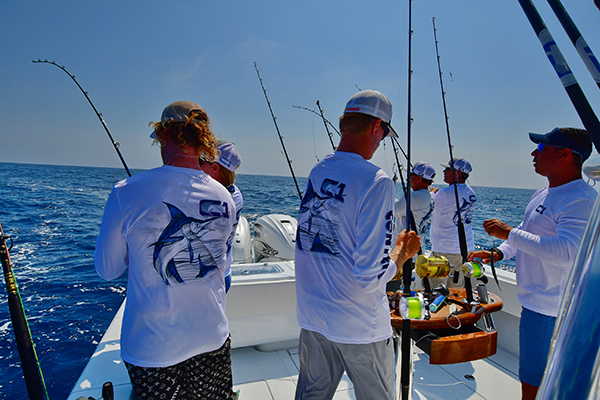
“Since we planned to fish marlin, we used a spread of mostly small, rigged ballyhoo on circle hooks and light conventional outfits,” Ken told us. “We also ran a pair of 80-pound outfits baited with rigged Spanish mackerel trailing the daisy chain teasers in case a blue came into the spread. We also had a few pitch bait rods in the rocket launcher ready to deploy if we hooked up so we could try and coax multiple hookups.” The big Contender was a sight to see with the full spread deployed behind the three big Yamaha engines.
“There is a lot of controversy about the ability of an outboard boat to raise billfishin a trolling tournament like this,” Ken said. “Some critics saying the harmonics of diesels and the wakes created by large sportfishermen bring marlin into the spread, while others disagree. I find that the quiet XTOs and the super clean wake are not a disadvantage at all, especially with white marlin. I run the spread very close to the boat and can stay on pods of bait near the surface without spooking them. We often get bites within a few yards of the transom.”
That was certainly the case during the day we spent with Contender One. Ken made a fast run to the deep off the Hudson Canyon, arriving well before lines in. As his team prepared the boat for trolling, getting the dredges and teasers ready, setting up the outriggers, positioning the rods and having plenty of baits rigged and ready, Ken motored around looking for bait and fish on the depth finder. When he found a few bait pods and marlin marks, he stayed on them for the rest of the day. The quiet engines didn’t seem to bother the bait schools in the least. During that time white marlin came into the spread periodically attacking the dredges and rigged baits very close to the boat. While none of them made the minimum length, they put him in contention for the billfish release prizes.
“I’ve got to give Yamaha a big shout out for the latest electronic controls and Helm Master® EX system for its effectiveness when trolling,” Pontari said. “The single-lever function makes controlling engine RPM and trolling speed pinpoint accurate. The Yamaha autopilot system also made running patterns a breeze within the area where we knew the bait was holding.” When we asked Ken about advantages and disadvantages between the battlewagons and the outboard contingent in these events, he didn’t pull any punches.
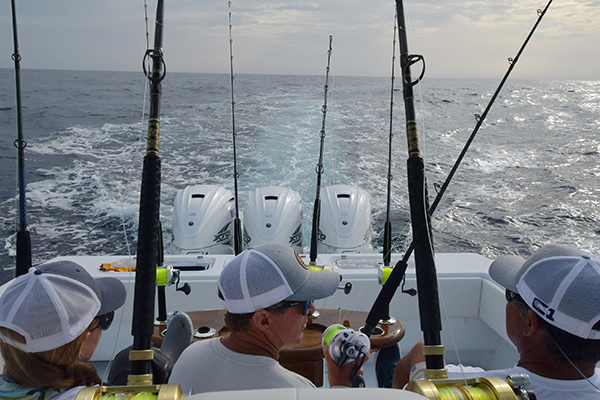
“The biggest disadvantage for us is the big use of Omni sonar,” he said. “All of the winning marlin caught by the big boats were seen on the Omni well away from the boat and then trolled over for the bite. The system is very expensive, but there are outboard guys willing to spend the bucks to compete, we just haven’t worked out the challenges involved in putting one in our boats, yet.” The Omni system requires molding a large sea chest into the hull to house the transducer, which has to be drawn up when running and then lowered into operating position only at trolling speeds.
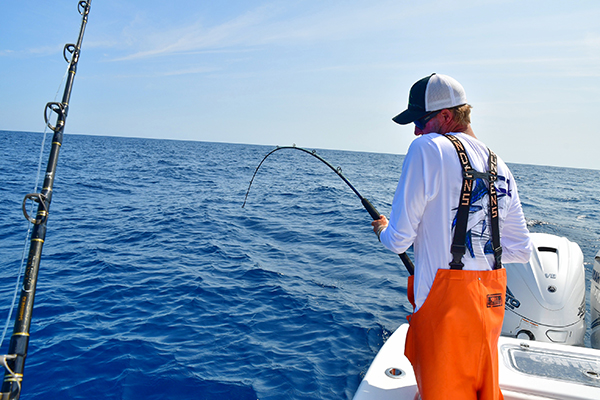
Ken mentioned that center consoles have an advantage when fighting fish. When you hook one, the angler can move to the bow or anyplace along the side of the boat to fight it, while the rest of the crew continues to troll and work pitch baits from the stern trying for a second and third bite. He also said the big boats might have a small advantage in keeping the crew and anglers more rested on the ride out in the morning (sleeping in airconditioned comfort in salons and staterooms), but that is offset by the speed of the outboard boats that allow them to reach their fishing spots with time to get ready and maybe relax a little along the way. The bigger outboard boats have comfortable seating for the entire crew and in a pinch, there’s always a cushy beanbag. Ken told us the Seakeeper® gyrostabilizer on the Contender reduce angler fatigue both while running and trolling.
Capt. Paul Robertson – Fishing for Muscular Dystrophy (FFMD)
Team FFMD had been on the tournament trail for the past six years, fishing 10 major billfish tournaments each year that stretch from the Mid-Atlantic to Florida, and even the Blue Marlin Classic out of Biloxi, Mississippi. The team fishes from a highly customized 43-foot Everglades® center console powered by four Yamaha XTO outboards. Paul is an Ocean City, Maryland, native with years of experience competing in Mid-Atlantic events. He knows the waters and much of the competition.
“We’re not intimidated fishing against the big boats,” Paul said without hesitation, “but I guess it’s because we’ve fished over 50 billfish tournaments in the past six years and the big boats represent most of the competition. We’ve done well considering our team is made up of volunteers who pay their own expenses for travel to be involved in the whole Fishing for Muscular Dystrophy program. We dedicate a major portion of the winnings to MDA® and do a lot of outreach on their behalf.”
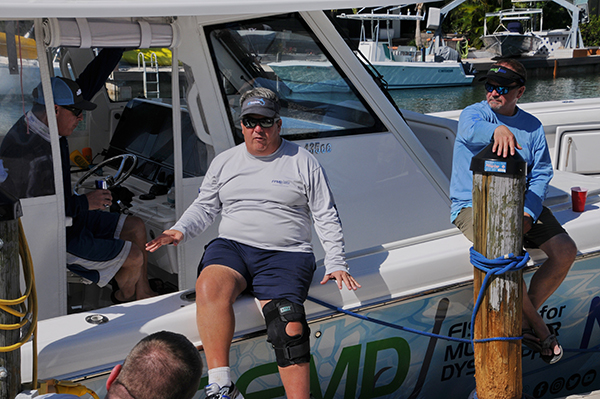
Over the last three years, the team finished in the money in the White Marlin Open three times, twice at the Buccaneer Cup Sailfish Tournament and recently took second place overall in the Huk® Overnight Big Fish Tournament. They won a number of other Calcutta payouts, too.
“Our Everglades is a great boat to fish tournaments, weighing in at 30,000 pounds,” he said. “The weight combined with the 1700 Yamaha horsepower and Seakeeper gives it a superb ride. We can easily run offshore at 45 to 50 knots and make quick moves from one spot to another in a matter of minutes. The six helm chairs under the hardtop are also protected by a full enclosure that keeps the crew comfortable and dry for the rides out and back during a tournament, so we don’t feel we give up much in comfort to
the big boats.”
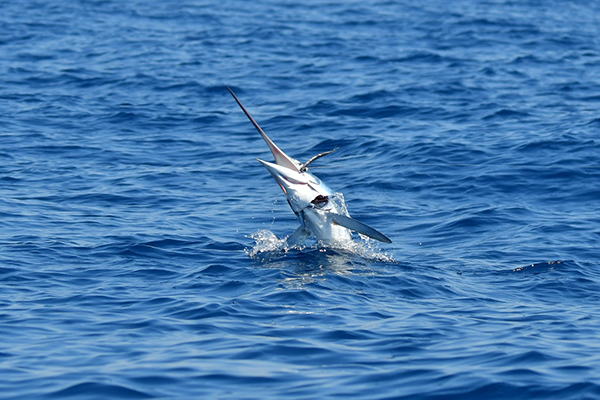
Paul and team are all about billfish, and that’s always their target species in these events. They look for the big fish to weigh in, rather than release trophies in many of tournaments. Their boat is rigged specifically for that purpose, running dredges from 11-foot Ledge Logic booms, teasers from electric reels on the tower, and loaded with rigged ballyhoo as the primary hook baits with some larger baits for blue marlin should they materialize. “This all helps us be more efficient so we can fish against the big boats using the same techniques they have at their disposal.”
“We’ve used Yamaha’s V8 outboards exclusively on our boats since starting this program, first the F350s and now we’re powered by four XTOs,” Paul said. “Their performance and reliability have been one of the keys to our ability to compete with confidence in these challenging events.”
The Jimmy Johnson Quest for the Ring – Atlantic City event is in the record books for this year, and it was a total success. Comments by all the competitors we talked with afterward were extremely positive. The venue and the fishing did not disappoint, and the promoters did an admirable job, especially considering this was a first-year event. The Yamaha team looks forward to returning to Atlantic City next July for the second running of the Quest-AC. Back to Blue Life
This July, NFL® Hall of Fame Coach Jimmy Johnson brought his popular Quest for the Ring® Billfish Tournament Series North to the New Jersey resort town Atlantic City, and with it the opportunity for many tournament teams that have not experienced that level of competition and excitement to get in on the action.
Among them is a growing contingent of teams running high-powered center console boats ready to pit their skill, equipment and determination against an almost overwhelming field of much larger battlewagons—diesel-powered offshore fishing yachts, some as large as 90 feet. The big boats are managed by professional captains, crews and anglers, some even with hired guns paid to fish because of their level of expertise. These multimillion-dollar boats travel the eastern seaboard competing in big-money offshore tournaments from the Mid-Atlantic to Florida, the Bahamas, the Gulf of Mexico and even further south. Competing at this level is not for the faint of heart, or lean of pocketbook.

The Quest series has its roots in Florida, where it set the pace for high-stakes billfish tournaments during its inaugural tournament ten years ago. The latest series started with the new Atlantic City event in July, followed by the Miami Tournament of Champions, and it finishes up with the Championship Fishing Week event in South Florida. Yamaha is a multi-year sponsor of these tournaments and the Yamaha team has seen the number of outboard-powered boats competing in them increase significantly, especially in the Florida events. The advent of larger, faster center consoles sporting the latest generation of offshore outboards like Yamaha’s powerhouse 425-horsepower XTO Offshore® system makes them surprisingly competitive in southern waters where the target species is sailfish, typically found close to shore. That is not the case with the Atlantic City event, where the target species are white and blue marlin along with bigeye and yellowfin tuna - all canyon dwellers that typically require a run of up to 100 miles to get to the fishing grounds before lines in the water each day.
We spoke with three Yamaha pro captains and rode along with two on fishing days during the Quest to get their opinions and to provide a better understanding of the planning and execution that goes into competing at this level. Two weeks after the Quest tournament, all three teams competed again in the largest and richest billfish tournament of them all, the White Marlin Open in Ocean® City, Maryland.

Capt. Freddy Gamboa – Andrea’s Toy
Freddy is a highly regarded charter captain from New Jersey who spends a good deal of his time offshore chasing tuna for his loyal clientele. His current boat is a 44 ST Contender® center console powered by four Yamaha XTO outboards for a total of 1700 horsepower. Recently highlighted in a Yamaha Saltwater Fishing feature on his techniques for run and gun tuna, Freddy is somewhat of a neophyte when it comes to fishing prestigious high-dollar tournaments like the Quest series. We rode along on the first fishing day to shoot pictures and watch his team in action.
“I’ve only been fishing the big offshore tournaments for the past three or four years, usually only two or three a year,” Gamboa said. He also fishes a few local offshore tournaments held near his home port in Pt. Pleasant, New Jersey. Two of his regular clients, T.J. Miller and Chris Vaughn, chartered his boat for this event. The remainder of the team consisted of seasoned captains and deckhands who have worked with him for years.
“My initial strategy was to concentrate on the tuna category, which offered a cash purse equal to the blue and white marlin categories,” Freddy said. “We ran a trolling spread of mostly lures and spreader bars the first day trying to tempt a bite from a large bigeye tuna. They turned out to be pretty elusive so we switched up for the next two days to include a mix of lures and rigged ballyhoo. We slowed our trolling speed to five-to-six knots to accommodate the ballyhoo and fished deeper water more likely to hold billfish.

Freddy’s trolling spread included four tracker chains with ballyhoo on circle hooks, two ballyhoo under weighted Joe Shute skirts, two marlin plugs off the short riggers, one dredge bar and three Nomad® plugs run from flatlines. The change produced three tuna, one blue marlin and one white marlin release on the last day of fishing. Neither billfish was large enough to bring to the scales. As luck would have it, one minute after “lines out” on the last day of fishing, they hooked a very large white marlin, fought it to the boat, measured and released it. Chances are it would have won the white marlin division and received a very hefty payout since it was two inches longer than the winning fish. That’s tournament fishing for you. With all the planning and execution, sometimes mere seconds can be the difference between winning and losing.
When we asked Freddy about the advantages and disadvantages of fishing from an outboard powered boat against a large field of battlewagons with pro teams, he provided the following perspective.
“One of our advantages is speed. Sure, some of the big boats are fast, but we beat them to the grounds every day, often by an hour or more, which gave us extra time to look around while waiting for lines in,” he said. “The XTOs on my Contender are fast, powerful, smooth and dependable. They help offset some of the advantages the big boats have, but not all. The most difficult for us to overcome is many big boats are now equipped with Omni sonar, basically underwater radar. It can scan 360-degrees around the boat and dial in to track gamefish in real time. At one point, we were in the neighborhood of a bigeye tuna bite. The school of large tuna had five or six of the big boats tracking them with Omni, and they literally boxed out the competition from getting anywhere near those fish as they hooked one after another.”
.jpg)
Capt. Ken Pontari – Contender One
The factory tournament boat from Contender Boats, Contender One, has been a fixture in the Jimmy Johnson Quest tournaments since the inception of the series, in addition to other southern sailfish and offshore tournaments stretching further back than that. Like Yamaha, Contender is a sponsor of some of these events. The Atlantic City Quest event marked the first time Contender One ventured this far north to compete, and they needed a ringer at the helm. Luckily, they had one in house in Ken Pontari, the company production manager. Ken is a captain in his own right and a New Jersey native with years of experience fishing Mid-Atlantic bluewater tournaments from larger sportfishing boats. We caught up with Ken on the third day of the tournament for a ride-along to watch and photograph his team in the heat of battle. The team was made up of Contender/Yamaha pro staff members, Amanda Sabin, Contender’s director of marketing, and other company employees.
Pontari planned to target marlin exclusively, and he had the triple-Yamaha XTO powered 44 ST rigged for the task. In addition to the 22-foot outriggers, the boat was equipped with two of the latest Gemlux® 8-foot dredge booms mounted with LP® electric reels for fast deployment and retrieval of the heavy mullet dredges he used to attract marlin. He mounted the booms in rod holders opposite the lower helm station to give the boat a wider spread between the port and starboard dredges, and to get them out in the cleanest water to add to their power of attraction. In addition, he ran a pair of chain teasers from electric teaser reels mounted on the boat’s marlin tower, the perch where he spent his time while trolling so he could better scan the water and watch for billfish coming into the trolling spread.

“Since we planned to fish marlin, we used a spread of mostly small, rigged ballyhoo on circle hooks and light conventional outfits,” Ken told us. “We also ran a pair of 80-pound outfits baited with rigged Spanish mackerel trailing the daisy chain teasers in case a blue came into the spread. We also had a few pitch bait rods in the rocket launcher ready to deploy if we hooked up so we could try and coax multiple hookups.” The big Contender was a sight to see with the full spread deployed behind the three big Yamaha engines.
“There is a lot of controversy about the ability of an outboard boat to raise billfishin a trolling tournament like this,” Ken said. “Some critics saying the harmonics of diesels and the wakes created by large sportfishermen bring marlin into the spread, while others disagree. I find that the quiet XTOs and the super clean wake are not a disadvantage at all, especially with white marlin. I run the spread very close to the boat and can stay on pods of bait near the surface without spooking them. We often get bites within a few yards of the transom.”
That was certainly the case during the day we spent with Contender One. Ken made a fast run to the deep off the Hudson Canyon, arriving well before lines in. As his team prepared the boat for trolling, getting the dredges and teasers ready, setting up the outriggers, positioning the rods and having plenty of baits rigged and ready, Ken motored around looking for bait and fish on the depth finder. When he found a few bait pods and marlin marks, he stayed on them for the rest of the day. The quiet engines didn’t seem to bother the bait schools in the least. During that time white marlin came into the spread periodically attacking the dredges and rigged baits very close to the boat. While none of them made the minimum length, they put him in contention for the billfish release prizes.
“I’ve got to give Yamaha a big shout out for the latest electronic controls and Helm Master® EX system for its effectiveness when trolling,” Pontari said. “The single-lever function makes controlling engine RPM and trolling speed pinpoint accurate. The Yamaha autopilot system also made running patterns a breeze within the area where we knew the bait was holding.” When we asked Ken about advantages and disadvantages between the battlewagons and the outboard contingent in these events, he didn’t pull any punches.

“The biggest disadvantage for us is the big use of Omni sonar,” he said. “All of the winning marlin caught by the big boats were seen on the Omni well away from the boat and then trolled over for the bite. The system is very expensive, but there are outboard guys willing to spend the bucks to compete, we just haven’t worked out the challenges involved in putting one in our boats, yet.” The Omni system requires molding a large sea chest into the hull to house the transducer, which has to be drawn up when running and then lowered into operating position only at trolling speeds.

Ken mentioned that center consoles have an advantage when fighting fish. When you hook one, the angler can move to the bow or anyplace along the side of the boat to fight it, while the rest of the crew continues to troll and work pitch baits from the stern trying for a second and third bite. He also said the big boats might have a small advantage in keeping the crew and anglers more rested on the ride out in the morning (sleeping in airconditioned comfort in salons and staterooms), but that is offset by the speed of the outboard boats that allow them to reach their fishing spots with time to get ready and maybe relax a little along the way. The bigger outboard boats have comfortable seating for the entire crew and in a pinch, there’s always a cushy beanbag. Ken told us the Seakeeper® gyrostabilizer on the Contender reduce angler fatigue both while running and trolling.
Capt. Paul Robertson – Fishing for Muscular Dystrophy (FFMD)
Team FFMD had been on the tournament trail for the past six years, fishing 10 major billfish tournaments each year that stretch from the Mid-Atlantic to Florida, and even the Blue Marlin Classic out of Biloxi, Mississippi. The team fishes from a highly customized 43-foot Everglades® center console powered by four Yamaha XTO outboards. Paul is an Ocean City, Maryland, native with years of experience competing in Mid-Atlantic events. He knows the waters and much of the competition.
“We’re not intimidated fishing against the big boats,” Paul said without hesitation, “but I guess it’s because we’ve fished over 50 billfish tournaments in the past six years and the big boats represent most of the competition. We’ve done well considering our team is made up of volunteers who pay their own expenses for travel to be involved in the whole Fishing for Muscular Dystrophy program. We dedicate a major portion of the winnings to MDA® and do a lot of outreach on their behalf.”

Over the last three years, the team finished in the money in the White Marlin Open three times, twice at the Buccaneer Cup Sailfish Tournament and recently took second place overall in the Huk® Overnight Big Fish Tournament. They won a number of other Calcutta payouts, too.
“Our Everglades is a great boat to fish tournaments, weighing in at 30,000 pounds,” he said. “The weight combined with the 1700 Yamaha horsepower and Seakeeper gives it a superb ride. We can easily run offshore at 45 to 50 knots and make quick moves from one spot to another in a matter of minutes. The six helm chairs under the hardtop are also protected by a full enclosure that keeps the crew comfortable and dry for the rides out and back during a tournament, so we don’t feel we give up much in comfort to
the big boats.”

Paul and team are all about billfish, and that’s always their target species in these events. They look for the big fish to weigh in, rather than release trophies in many of tournaments. Their boat is rigged specifically for that purpose, running dredges from 11-foot Ledge Logic booms, teasers from electric reels on the tower, and loaded with rigged ballyhoo as the primary hook baits with some larger baits for blue marlin should they materialize. “This all helps us be more efficient so we can fish against the big boats using the same techniques they have at their disposal.”
“We’ve used Yamaha’s V8 outboards exclusively on our boats since starting this program, first the F350s and now we’re powered by four XTOs,” Paul said. “Their performance and reliability have been one of the keys to our ability to compete with confidence in these challenging events.”
The Jimmy Johnson Quest for the Ring – Atlantic City event is in the record books for this year, and it was a total success. Comments by all the competitors we talked with afterward were extremely positive. The venue and the fishing did not disappoint, and the promoters did an admirable job, especially considering this was a first-year event. The Yamaha team looks forward to returning to Atlantic City next July for the second running of the Quest-AC. Back to Blue Life